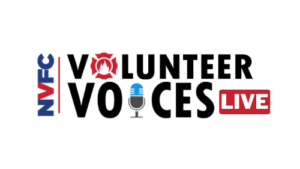Ideas for Improving Fire Department Communications: A Volunteer Voices Live Discussion
March 8, 2022
 On February 23, the National Volunteer Fire Council (NVFC) hosted its inaugural “Volunteer Voices Live: Face-to-Face Virtual Connections,” a new interactive discussion format that takes a conversation happening in the NVFC’s Volunteer Voices online community and facilitates a live discussion on the topic via Zoom. The topic this time focused on improving communications within a fire or EMS department.
On February 23, the National Volunteer Fire Council (NVFC) hosted its inaugural “Volunteer Voices Live: Face-to-Face Virtual Connections,” a new interactive discussion format that takes a conversation happening in the NVFC’s Volunteer Voices online community and facilitates a live discussion on the topic via Zoom. The topic this time focused on improving communications within a fire or EMS department.
The discussion was facilitated by Dr. Candice McDonald, first vice president of the Cumberland Valley Volunteer Firemen’s Association and active volunteer firefighter, and Hersch Wilson, retired assistant chief at the Hondo Volunteer Fire Department (Santa Fe, NM). To provide a space where people can talk respectfully but freely, the session was not recorded.
The conversation, which lasted about an hour, was centered on barriers to and strategies for improving communication in the volunteer fire department. The goal was to provide participants with at least one new communication strategy they could implement in their department right away. Ideas that came out of the session include the following:
Respect and Recognition
The importance of respect and recognition was discussed in-depth. Remember the golden rule (treat others as you would like to be treated) and to use respect in all communication. Be aware that not everyone processes things the same way. Try to learn the name of everyone in your department along with at least one thing about them, as this makes communication easier and interactions more meaningful. Publicly recognize department members with words of praise and affirmation and save discipline for private settings.
Negativity and Gossip
Facilitators and participants discussed the detrimental effects that negativity and gossip can have on department morale. Solutions include keeping members who tend to be negative busy by tasking them to solve the problems they complain about, as well as limiting gossip by speaking up when a conversation becomes uncomfortable or inappropriate.
Communication Frequency and Methods
Participants discussed how email is not necessarily the best method of communication for everyone. To avoid constantly sending members emails or texts, consider developing a one-stop self-help web site or page for your department that includes key messages, a calendar, training schedules, and other important information. Alternatively, departments can use messaging apps such as GroupMe or WhatsApp, which are free, and in WhatsApp’s case, encrypted. Some departments also use a dispatch app (such as MyLocalSafety) to send push notifications to members.
Mentors and Performance Reviews
New volunteers can be assigned a mentor who serves to make them feel welcome and answer any questions they are bound to have. Conduct regular performance reviews for both department members and leadership. Reviews allow leadership to determine what members want for the future of the department and allow members to evaluate leadership and convey their personal goals and aspirations.
After Action Reviews
Conduct After Action Reviews following incidents to allow communication on what was intended to be done, what was actually done, what worked, what could be done differently next time, and what procedures may need to be changed.
NVFC members can continue this discussion or join many more in the Volunteer Voices online community. Not a member? Join now for only $21 per year.
More Volunteer Voices Live events are planned for 2022. These discussions are open to all members of the fire and emergency services as a place to share ideas, learn from each other, and have friendly and respectful face-to-face discussions. Stay tuned to the NVFC’s web site and Facebook, Twitter, and LinkedIn pages for more information.



